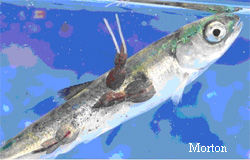SOUTH PADRE ISLAND — Sea lice — it’s also known as beach lice, sea bather’s eruption, pika-pika and ocean itch.
Those are just some of the names given to a rash caused by a minuscule creature that often invades summer waters on the Gulf coast and the Caribbean, pestering swimmers with nasty bumps and sometimes flu-like symptoms.
Unable to be seen by the human eye, sea lice are as tiny as a speck of pepper. In fact, it’s not lice at all but microscopic jellyfish larvae.
According to health officials in Florida, sea lice have been popping up for more than a century. Just recently, Florida has been reporting several cases of this minuscule menace.
Locally, researchers say there is nothing to worry about.
Hudson Deyoe, director of the coastal studies lab on South Padre Island, said right now sea lice are not present on any local beaches.
However, that could change between now and July, the time when sea lice are most active.
For the rest of this story and many other EXTRAS, go to our premium site, www.MyValleyStar.com.
Subscribe to it for only $6.99 per month or purchase a print subscription and receive the online version free, which includes an electronic version of the full newspaper and extra photo galleries, links and other information you can’t find anywhere else.
First, look for a warning flag at the beach. That’s a sign that there’s dangerous marine life in the water and it’s best to stay away.
Health officials also advise wearing as little clothing as possible (such as leaving off a T-shirt) in the water to lessen the area that could trap the lice.
Beach goers are advised to change out of their bathing suits as soon as possible and then take a freshwater shower with no clothes on.
You should also wash your bathing suit with detergent and dry it under high heat to kill any of the jellyfish.
Don’t take a freshwater shower with your bathing suit on though, as this will cause the stinging cells in the fabric to fire and release more venom.
Some health officials advise wearing a waterproof moisturizer, such as zinc oxide, or layers of petroleum jelly to block the stings.
According to the Department of Health, there is some evidence that using a topical sunscreen or suntan lotion could actually protect your skin from penetration by the sea lice.
And if you’re stung by sea lice?
Health officials recommend treating the rash with an antihistamine or hydrocortisone cream, as well as bathing in colloidal oatmeal and applying calamine lotion to reduce the rash and itchiness.
Antihistamines can also help, though they shouldn’t be used with the hydrocortisone creams or calamine lotion unless directed by a doctor. If you develop a fever, medical experts advise contacting a physician.
More serious symptoms can include difficulty in sleeping, nausea, vomiting, diarrhea, headaches, weakness and muscle spasms.




